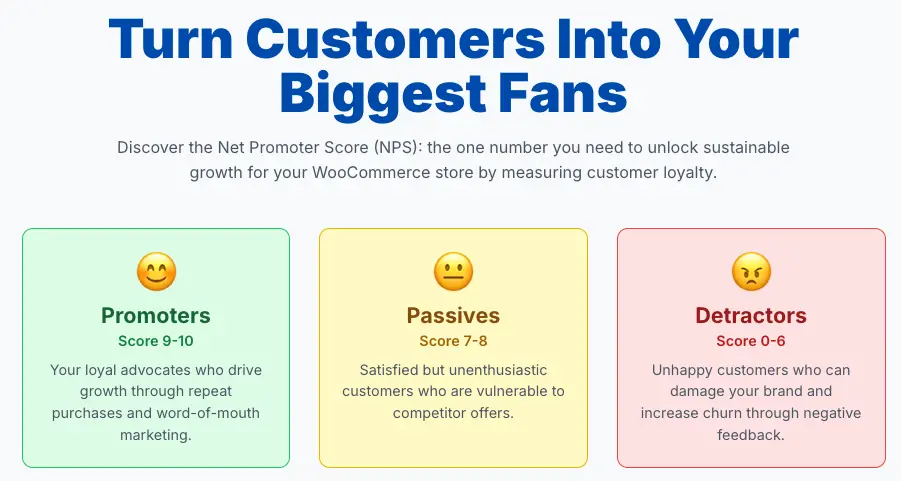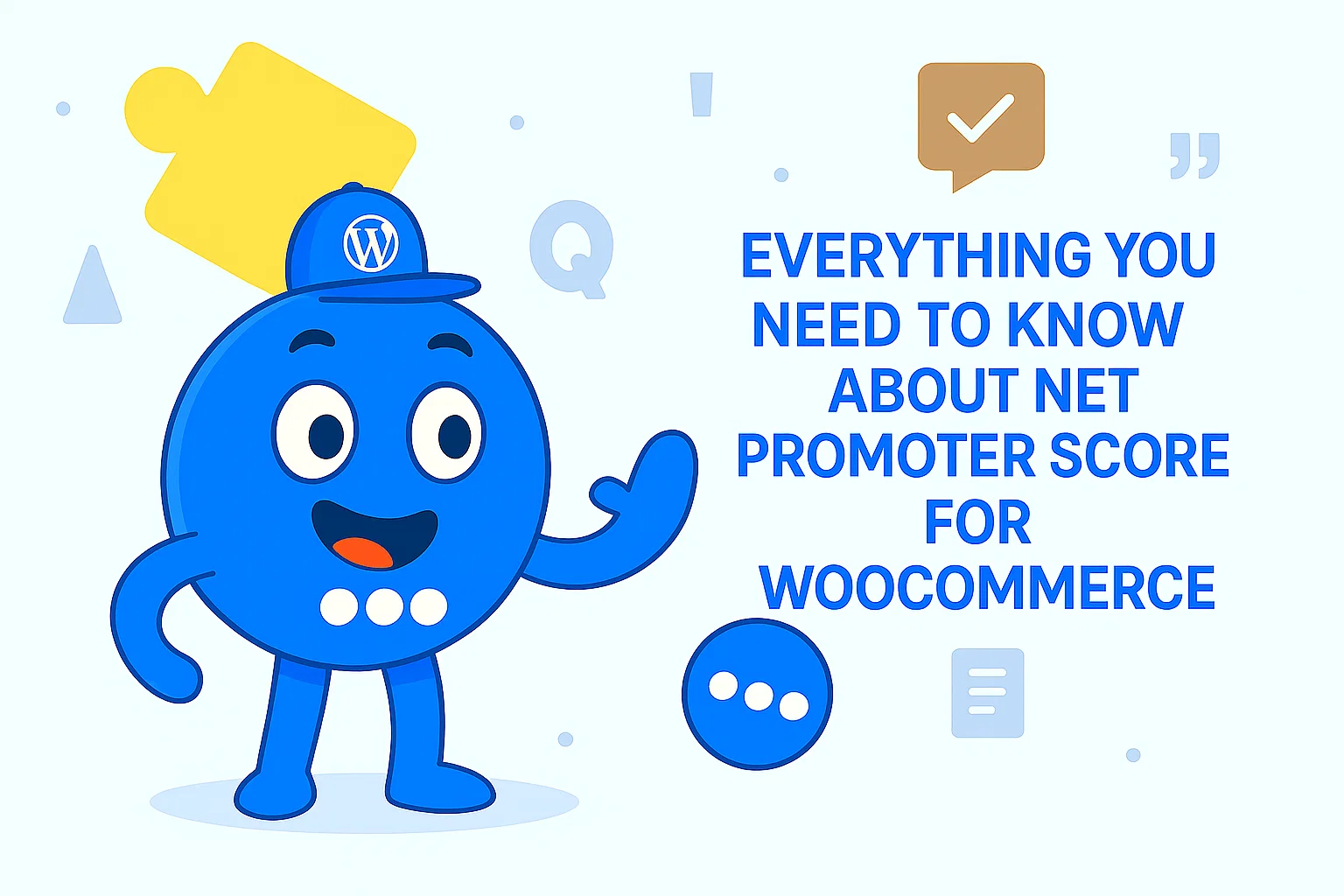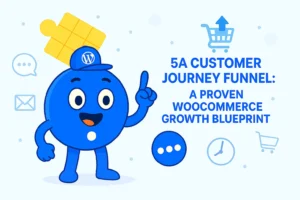Everything You Need to Know About Net Promoter Score for WooCommerce
The Net Promoter Score (NPS) stands as a cornerstone customer experience metric, widely recognized as the “gold standard” for measuring customer loyalty and satisfaction. It quantifies the likelihood of customers recommending a business, offering a direct and powerful indicator of brand health and growth potential within the competitive e-commerce landscape.
For WooCommerce merchants, implementing NPS is far more than just collecting a score; it serves as a powerful diagnostic tool for business vitality. A robust NPS directly correlates with accelerated revenue growth, significantly improved customer retention rates, and the invaluable generation of organic word-of-mouth marketing, all of which are critical drivers for sustainable success in online commerce.
The e-commerce sector exhibits a notably higher average NPS compared to other industries, such as financial services or telecommunications. This variance suggests that customer expectations and loyalty drivers differ significantly based on the business type.
For online retailers, a “good” score is comparatively high, indicating that e-commerce customers are often more discerning and readily recommend positive experiences due to the direct, transactional nature of digital interactions and the ease of switching providers.
The Power of Net Promoter Score (NPS) for WooCommerce

Defining NPS: Calculation, Promoters, Passives, and Detractors
The Net Promoter Score (NPS) is a customer experience metric designed to quantify customer loyalty by posing a single, direct question: “How likely are you to recommend to a friend or colleague?“. Responses are captured on an 10-point scale, ranging from 0 (not at all likely) to 10 (extremely likely), and are then categorized into three distinct groups:
- Promoters (9-10): These represent the most loyal and enthusiastic customers. They are highly inclined to recommend a brand to others and consistently make repeat purchases. Promoters are invaluable assets, generating positive word-of-mouth marketing and driving organic business expansion.
- Passives (7-8): These customers are satisfied with the service received but lack the fervent enthusiasm characteristic of promoters. They are generally unenthusiastic and remain susceptible to competitive offerings. Although not directly included in the core NPS calculation, they represent a significant opportunity for improvement and conversion into promoters.
- Detractors (0-6): These are unhappy customers who are unlikely to recommend a business. More critically, they may actively disseminate negative word-of-mouth, potentially damaging brand reputation and impeding growth.
The Net Promoter Score is calculated by subtracting the percentage of Detractors from the percentage of Promoters. The final score is presented as a number ranging from -100 (indicating all respondents are detractors) to +100 (indicating all are promoters).
Historical Context and Evolution of NPS
The NPS methodology was first conceived in 2003 by Fred Reichheld, in collaboration with software provider Satmetrix and the business consultancy Bain & Company, Inc. Its conceptual origins can be traced back to a case study presented by former Enterprise Car Rentals CEO Andy Taylor, who demonstrated the efficacy of measuring customer loyalty through a concise set of key questions. Since its inception, NPS has rapidly evolved to become a widely adopted “gold standard” metric, utilized by millions of businesses globally to gauge and track customer perception.
Why NPS is Indispensable for Online Businesses
NPS offers a direct snapshot of the overall customer experience. High scores inherently point to a high level of customer satisfaction and a positive customer journey, helping organizations understand how content customers are with their products and services.
A low NPS is a strong indicator that a company faces an elevated risk of increased customer churn. It enables organizations to proactively identify dissatisfied customers who might be contemplating departure, allowing for timely intervention. Furthermore, integrating customer churn data with NPS can significantly enhance the accuracy of predicting when a customer is likely to cancel or unsubscribe.
Promoters are not merely loyal customers; they are active advocates who help organizations scale through positive word-of-mouth recommendations. Conversely, a substantial number of detractors can actively impede business growth by spreading negative sentiment. Loyal customers effectively provide invaluable, free marketing for a brand.
The link between NPS and financial performance is robust. Companies with consistently high NPS scores have demonstrated the ability to achieve 2.5 times the revenue growth of their competitors. NPS directly correlates with both revenue growth and customer retention, offering crucial insights into the overall health and future growth potential of a business.
Challenges and Limitations of NPS
Despite its widespread adoption and benefits, NPS is not without its challenges. Given the specificity of the single NPS question, it does not always convey the complete narrative behind customer sentiment. A company might have many satisfied customers who, for various reasons, simply do not intend to recommend, which could be inaccurately perceived as dissatisfaction.
To achieve sufficient response rates, companies may need to send multiple survey requests. This aggressive approach can sometimes backfire, potentially influencing more negative scores from respondents who are annoyed by the persistent survey tactics. This underscores the importance of thoughtful survey design and optimal timing.
NPS Benchmarks and Impact on E-commerce Growth

Average NPS Scores for the E-commerce Industry and What Constitutes a “Good” Score
Understanding where a WooCommerce site’s NPS stands relative to industry benchmarks is crucial for effective strategy. Generally, any NPS score above 0 is considered good, indicating that there are more promoters than detractors.
- Scores above 20 are deemed favorable.
- Scores above 50 are considered excellent.
- Scores above 80 are indicative of world-class customer loyalty.
For the e-commerce sector specifically, the average NPS currently hovers around 62, signifying a generally healthy level of customer satisfaction within the industry. Top-performing e-commerce businesses are setting a new standard, consistently achieving NPS scores between 70 and 80. An NPS below zero, where detractors outnumber promoters, signals critical issues that can actively damage brand reputation and lead to high churn rates.
Direct Correlation Between High NPS and Increased Revenue Growth, Customer Lifetime Value (CLV), and Retention Rates for E-commerce

The importance of NPS extends beyond mere satisfaction; it directly correlates with tangible business outcomes for e-commerce sites:
- Revenue Growth: Companies that achieve a high NPS can experience revenue growth that is 2.5 times greater than their competitors. This is because loyal customers, identified as promoters, not only continue to make purchases themselves but also drive new business through their recommendations. Even a modest improvement of just 7 points in NPS can lead to an annual revenue growth of up to 1%.
- Customer Lifetime Value (CLV): Promoters are significantly more valuable customers. They typically spend 67% more than new customers and exhibit a 90% higher purchase frequency. Over their customer lifetime, promoters spend 3.5 times more than detractors. Furthermore, when a customer transitions from passive to promoter status, their lifetime value increases by approximately 22%. Companies that effectively track and leverage CLV can see their profits increase by as much as 95%.
- Customer Retention: Higher NPS scores are directly linked to significantly improved customer retention rates. Loyal customers, identified through NPS surveys, are far less likely to churn, and their continued patronage contributes to stable, predictable revenue streams. The cost-effectiveness of retention is profound, as retaining an existing customer costs 5-25 times less than acquiring a new one.
Table 1: NPS Score Interpretation & E-commerce Benchmarks
| NPS Score Range | Interpretation | E-commerce Benchmark Context | Actionable Implications for WooCommerce |
| -100 to 0 | Critical Issues (Detractors Outnumber Promoters) | Significantly below the average eCommerce NPS of ~62. This indicates severe customer dissatisfaction and a high risk of customer churn. | Immediate and thorough root-cause analysis is critical, focusing on feedback from detractors. Prioritize fixing core product/service deficiencies, addressing customer support shortcomings, or resolving critical checkout friction points. Implement rapid, personalized follow-up with unhappy customers to mitigate negative impact. |
| 1 to 20 | Good (More Promoters than Detractors, but many Passives) | Below the average for e-commerce. While positive, there is significant room to improve by converting passive customers into active promoters. | Strategically focus on converting Passives to Promoters. Identify and address minor friction points or seek opportunities to create “delight” in the customer journey. Consider personalized offers or enhanced experiences to encourage deeper loyalty and advocacy. |
| 21 to 50 | Favorable (Healthy, but not yet excellent) | This range is approaching or at the lower end of the average e-commerce NPS. It signifies a solid foundation but still presents clear opportunities to differentiate and excel. | Consolidate existing strengths and build upon them. Systematically address common themes identified in feedback from Passives. Actively seek out and implement “wow” moments throughout the customer journey. Continue to gather and analyze qualitative feedback for deeper insights. |
| 51 to 80 | Excellent to World-Class | This range aligns with or exceeds the average e-commerce NPS (62) and places a business among top-performing e-commerce stores (70-80). It indicates strong customer loyalty and active advocacy. | The primary focus shifts to maintaining these high standards. Actively leverage Promoters for testimonials, online reviews, and participation in referral programs. Explore and optimize loyalty programs. Continuously monitor and refine the customer journey to prevent complacency and sustain exceptional experiences. |
| 81 to +100 | World-Class (Exceptional Loyalty & Advocacy) | Represents the pinnacle of customer satisfaction and loyalty within the e-commerce sector. This score is achieved by a select few. | Concentrate efforts on sustaining this elite status. Innovate based on suggestions from Promoters and explore co-creation opportunities. Ensure consistent, delightful, and personalized experiences are delivered flawlessly across all customer touchpoints. |
Strategic Implementation of NPS Surveys on WooCommerce Sites

Best Practices for Designing User-Friendly and Effective NPS Surveys
Designing an NPS survey that encourages high response rates and yields actionable insights is crucial. The primary objective is to ensure a frictionless completion process, minimizing survey fatigue. Here are some key considerations for an effective NPS survey design:
- Simple Language and Clear Instructions: Use straightforward language and give clear guidance to avoid confusion.
- Minimize Required Fields: Only ask for essential information to keep the survey quick and easy.
- Progress Indicators: Show users how far along they are in the survey to reduce anxiety.
- Engaging Visuals: Keep the design clean and minimalistic to improve user experience and prevent survey fatigue.
- Brand Consistency: Align the survey’s look and feel with your WooCommerce store’s brand for trustworthiness.
While the core NPS question provides a quantitative score, open-ended questions or comment boxes are essential for understanding the reasons behind a customer’s rating. Questions such as “Why did you choose this specific score?” or “What could we do to improve your experience?” provide invaluable qualitative context.
By combining both quantitative and qualitative data, businesses can go beyond superficial insights and precisely pinpoint the factors—whether it’s product features, checkout flow inefficiencies, or customer service interactions—that are either improving or harming customer satisfaction. This integrated approach enables more accurate, data-driven improvements and effective problem-solving, leading to targeted enhancements rather than guesswork.
Optimal Timing and Distribution Methods for WooCommerce
The timing and method of survey distribution significantly impact response rates and data quality. For immediate, context-specific feedback, transactional NPS surveys should be sent shortly after a specific customer touchpoint, such as a completed purchase, a successful customer care resolution, or a specific product interaction.
This captures feedback while the experience is fresh in the customer’s mind. To gain a periodic pulse on overall customer sentiment and track the long-term health of customer relationships, relational NPS surveys should be deployed on a regular basis, such as quarterly or annually. This provides a benchmark for year-on-year success.
Regarding distribution channels, reaching logged-in customers directly on a WooCommerce website via pop-ups is an effective way to solicit quick responses. In-app surveys generally boast significantly higher response rates (averaging 92%) because users are most engaged when actively interacting with a site or service. They are highly contextually relevant when sent immediately after a key customer interaction.
While in-app surveys are ideal for immediate context, email surveys remain effective for gathering broader feedback or for following up with specific customer segments, such as disengaged users who may not be actively browsing the site. It is crucial to implement powerful targeting options to ensure surveys reach the most relevant audience at the optimal moment. This includes targeting by device (mobile vs. desktop), specific page levels, user behavior (e.g., exit intent), or by scheduling them in advance.
Integrating NPS with Existing WooCommerce Customer Data for Richer Insights
For WooCommerce sites, the true power of NPS is unlocked when integrated with the existing wealth of customer data. Segmenting NPS data based on various customer attributes—such as demographics, purchase behavior (e.g., buying frequency, recency of last purchase, monetary value), product usage, or their stage in the customer journey (e.g., new vs. long-term customers)—can reveal significant variations in satisfaction across distinct user groups.
This segmentation enables the personalization of retention strategies. If you wants to learn more about understanding WooCommerce analytics to better segment your customer you can read our WooCommerce Analytics Guide: Increase Sales with Smart Data Insights
Enhancing NPS Initiatives with the Floating Awesome Button WordPress Plugin

Overview of the Floating Awesome Button (FAB) Plugin: Core Features and Capabilities Relevant to Customer Interaction and Feedback
The Floating Awesome Button (FAB) plugin is positioned as a leading solution for WordPress, specifically designed to integrate dynamic, customizable “Smart Floating Buttons and Widgets” into a website. Its core purpose is to “boost the amount of interactions and conversions from your website visitors” by providing versatile engagement points. Key features that make FAB particularly relevant for enhancing NPS initiatives include:
Table 2: Floating Awesome Button Features & Their Application to NPS Strategy
| Floating Awesome Button Feature | FAB Capability | Direct Application to NPS Strategy for WooCommerce | Benefit for NPS Initiative |
| Pop-up Actions | Integrates with Contact Form 7 and WPForms. | Triggering NPS surveys as pop-ups post-purchase, after customer service interactions, or on specific product pages. | Seamless In-App Delivery: Captures immediate, contextual feedback, leading to higher response rates and more accurate data. |
| Display Rules (Targeting) | Show/hide based on device, pages, user role, time, scroll depth, exit intent, idle visitors. | Targeting specific customer segments (e.g., recent buyers, high-value customers, first-time visitors) or specific pages (e.g., thank-you page, support page) for surveys. | Precision Targeting: Ensures surveys reach the most relevant audience at the optimal moment, improving data quality and reducing survey fatigue. |
| On-Click Actions (Communication) | Click-to-Call, Mail, WhatsApp, Facebook Messenger, Social Sharing. | Providing direct communication channels for detractors to voice concerns, or for promoters to share positive feedback/reviews. | Effective Feedback Loop Closure: Facilitates rapid issue resolution for detractors and leverages promoters for advocacy, building stronger customer relationships. |
| Styling & Customization | Custom positioning, 400+ icons, custom images, colors, menu styles. | Branding NPS survey triggers with WooCommerce store’s look and feel, using relevant icons or calls-to-action. | Enhanced User Experience & Branding: Creates a professional, trustworthy survey experience, encouraging participation and reinforcing brand identity. |
| Analytics Dashboard | Auto-tracking button clicks, advanced analytics, conversion history. | Monitoring the performance of NPS survey triggers (e.g., click-through rates on “Rate Your Experience” buttons). | Optimization of Survey Deployment: Provides data to refine button placement, design, and timing for maximum survey completion rates. |
Leveraging FAB’s Built-in Analytics for Tracking Survey Interaction and Conversion
FAB’s integrated analytics dashboard, which provides auto-tracking of button clicks, is a powerful tool for optimizing the NPS collection process itself. This data allows WooCommerce merchants to monitor how users interact with their survey triggers. By analyzing these metrics, businesses can refine button placement, timing, and design for maximum engagement and response rates, ensuring the NPS collection mechanism is as efficient and effective as possible.

Conclusion and Recommendations
The Net Promoter Score is an indispensable metric for WooCommerce sites, offering a clear, quantifiable measure of customer loyalty that directly correlates with business health, revenue growth, and customer retention.
Beyond a simple satisfaction score, NPS provides a dynamic feedback mechanism that, when coupled with qualitative data, enables precise identification and resolution of customer pain points across the entire journey. The e-commerce sector’s higher NPS benchmarks underscore the need for WooCommerce businesses to strive for excellence in customer experience to remain competitive.
By strategically integrating NPS measurement with the dynamic capabilities of the Floating Awesome Button plugin and committing to data-driven customer experience improvements, WooCommerce businesses can not only measure loyalty but actively engineer it, leading to sustainable growth and a thriving customer base.







